What is Fylnetra?
Fylnetra is a man-made form of granulocyte colony-stimulating factor (G-CSF). G-CSF is a substance produced by the body. It stimulates the growth of neutrophils, a type of white blood cell important in the body’s fight against infection.
Who should not use Fylnetra?
Do not take Fylnetra if you have had a serious allergic reaction to pegfilgrastim products or filgrastim products.
What should I tell my healthcare provider before using Fylnetra?
Before you receive Fylnetra, tell your healthcare provider about all of your medical conditions, including if you:
- have a sickle cell disorder
- have kidney problems
- are pregnant or plan to become pregnant. It is not known if Fylnetra will harm your unborn baby.
- are breastfeeding or plan to breastfeed. It is not known if Fylnetra passes into your breast milk.
Tell your healthcare provider about all of the medicines you take, including prescription and over-the-counter medicines, vitamins, and herbal supplements.
How should I use Fylnetra?
- Fylnetra is given as an injection under your skin (subcutaneous injection) by a healthcare provider. If your healthcare provider decides that the subcutaneous injections can be given at home by you or your caregiver, follow the detailed “Instructions for Use” that comes with your Fylnetra for information on how to prepare and inject a dose of Fylnetra.
- You and your caregiver will be shown how to prepare and inject Fylnetra before you use it.
- You should not inject a dose of Fylnetra to children weighing less than 45 kg from a Fylnetra prefilled syringe. A dose less than 0.6 mL (6 mg) cannot be accurately measured using the Fylnetra prefilled syringe.
- If you are receiving Fylnetra because you are also receiving chemotherapy, the last dose of Fylnetra should be injected at least 14 days before and 24 hours after your dose of chemotherapy.
- If you miss a dose of Fylnetra, talk to your healthcare provider about when you should give your next dose.
What are the possible side effects of Fylnetra?
Fylnetra may cause serious side effects, including:
- Spleen rupture. Your spleen may become enlarged and can rupture. A ruptured spleen can cause death. Call your healthcare provider right away if you have pain in the left upper stomach area or your left shoulder.
- A serious lung problem called Acute Respiratory Distress Syndrome (ARDS). Call your healthcare provider or get emergency help right away if you have shortness of breath with or without a fever, trouble breathing, or a fast rate of breathing.
- Serious allergic reactions. Fylnetra can cause serious allergic reactions. These reactions can cause a rash over your whole body, shortness of breath, wheezing, dizziness, swelling around your mouth or eyes, fast heart rate, and sweating. If you have any of these symptoms, stop using Fylnetra and call your healthcare provider or get emergency medical help right away.
- Sickle cell crises. You may have a serious sickle cell crisis, which could lead to death, if you have a sickle cell disorder and receive Fylnetra. Call your healthcare provider right away if you have symptoms of sickle cell crisis such as pain or difficulty breathing.
- Kidney injury (glomerulonephritis). Fylnetra can cause kidney injury. Call your healthcare provider right away if you develop any of the following symptoms.
- swelling of your face or ankles
- blood in your urine or dark colored urine
- you urinate less than usual
- Increased white blood cell count (leukocytosis). Your healthcare provider will check your blood during treatment with Fylnetra.
- Decreased platelet count (thrombocytopenia). Your healthcare provider will check your blood during treatment with Fylnetra. Tell your healthcare provider if you have unusual bleeding or bruising during treatment with Fylnetra. This could be a sign of decreased platelet counts, which may reduce the ability of your blood to clot.
- Capillary Leak Syndrome. Fylnetra can cause fluid to leak from blood vessels into your body’s tissues. This condition is called “Capillary Leak Syndrome” (CLS). CLS can quickly cause you to have symptoms that may become life-threatening. Get emergency medical help right away if you develop any of the following symptoms:
- swelling or puffiness and are urinating less than usual
- trouble breathing
- swelling of your stomach area (abdomen) and feeling of fullness
- dizziness or feeling faint
- a general feeling of tiredness
- Myelodysplastic syndrome and acute myeloid leukemia. If you have breast cancer or lung cancer, when Fylnetra is used with chemotherapy and radiation therapy, or with radiation therapy alone, you may have an increased risk of developing a precancerous blood condition called myelodysplastic syndrome (MDS) or a blood cancer called acute myeloid leukemia (AML). Symptoms of MDS and AML may include tiredness, fever, and easy bruising or bleeding. Call your healthcare provider if you develop these symptoms during treatment with Fylnetra.
- Inflammation of the aorta (aortitis). Inflammation of the aorta (the large blood vessel which transports blood from the heart to the body) has been reported in patients who received pegfilgrastim products. Symptoms may include fever, abdominal pain, feeling tired, and back pain. Call your healthcare provider if you experience these symptoms.
The most common side effects of Fylnetra are pain in the bones, arms, and legs.
These are not all the possible side effects of Fylnetra.
Call your healthcare provider for medical advice about side effects. You may report side effects to FDA at 1-800-FDA1088.
General information about the safe and effective use of Fylnetra
Medicines are sometimes prescribed for purposes other than those listed in a Patient Information leaflet. Do not use Fylnetra for a condition for which it was not prescribed. Do not give Fylnetra to other people, even if they have the same symptoms that you have. It may harm them. You can ask your pharmacist or healthcare provider for information about Fylnetra that is written for health professionals.
How should I store Fylnetra?
- Store Fylnetra in the refrigerator between 360 F to 460 F (20 C to 80 C).
- Do not freeze.
- Keep the prefilled syringe in the original carton to protect from light or physical damage.
- Do not shake the prefilled syringe.
- Take Fylnetra out of the refrigerator 30 minutes before use and allow it to reach room temperature before preparing an injection.
- Throw away (dispose of) any Fylnetra that has been left at room temperature, 680 F to 770 F (200 C to 250 C), for more than 72 hours.
Keep the Fylnetra prefilled syringe out of the reach of children
What are the ingredients in Fylnetra?
Active ingredient: pegfilgrastim-pbbk
Inactive ingredients: acetic acid, polysorbate 20, sodium hydroxide, and sorbitol in water for injection.
For more information, go to www.fylnetra.us or call 1-877-835-5472.
Instructions for use for Fylnetra
Fylnetra (fil-ne-trah)
(pegfilgrastim-pbbk)
Injection, for subcutaneous use
Single-Dose Prefilled Syringe
Guide to parts
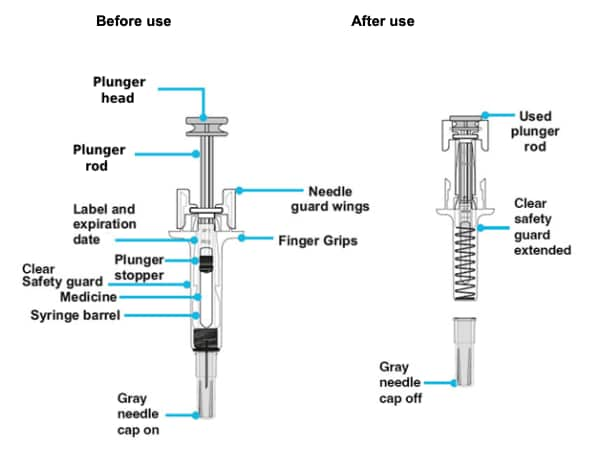
Important: The needle is covered by the gray needle cap before use.
Important
Read the Patient Information for important information you need to know about Fylnetra before using these Instructions for Use.
Before you use a Fylnetra prefilled syringe, read this important information.
Storing the prefilled syringe
- Store Fylnetra in the refrigerator between 36oF to 46oF (2oC to 8oC).
- Do not freeze.
- Keep the prefilled syringe in the original pack to protect from light or physical damage.
- Take the prefilled syringe out of the refrigerator 30 minutes before use and allow it to reach room temperature before preparing an injection.
- Throw away (dispose of) any Fylnetra that has been at left at room temperature, 68oF to 77oF (20oC to 25oC), for more than 72 hours.
- Keep the Fylnetra prefilled syringe out of the reach of children.
Using the prefilled syringe
- It is important that you do not try to give the injection unless you or your caregiver has received training from your healthcare provider.
- Make sure the name Fylnetra appears on the pack and prefilled syringe label.
- Check the pack and prefilled syringe label to make sure the dose strength is 6 mg/0.6 mL.
- You should not inject a dose of Fylnetra to children weighing less than 45 kg from a Fylnetra prefilled syringe. A dose less than 0.6 mL (6 mg) cannot be accurately measured using the Fylnetra prefilled syringe.
- Do not use a prefilled syringe after the expiration date on the label.
- Do not shake the prefilled syringe.
- Do not remove the gray needle cap from the prefilled syringe until you are ready to inject.
- Do not use the prefilled syringe if the pack is open or damaged.
- Do not use a prefilled syringe if it has been dropped on a hard surface. The prefilled syringe may be broken even if you cannot see the break. Use a new prefilled syringe.
- Do not attempt to activate the needle safety guard prior to injection.
- Do not reuse a Fylnetra prefilled syringe. Throw away (dispose of) the Fylnetra A prefilled syringe right away after use. See Step 10: “Disposing of used prefilled syringes”.
Call your healthcare provider if you or your caregiver have any questions.
Step 1: Prepare
A. Gather all materials needed for the injection.
Wash your hands well with soap and water.
On a clean, well-lit work surface place the following supplies:
Included in the pack:
- Fylnetra prefilled syringe
Not included in the pack:
- Alcohol wipe
- Cotton ball or gauze pad
- Adhesive bandage
- Sharps disposal container. See "Step 10: Disposing of used Fylnetra prefilled syringes” for information on disposal.
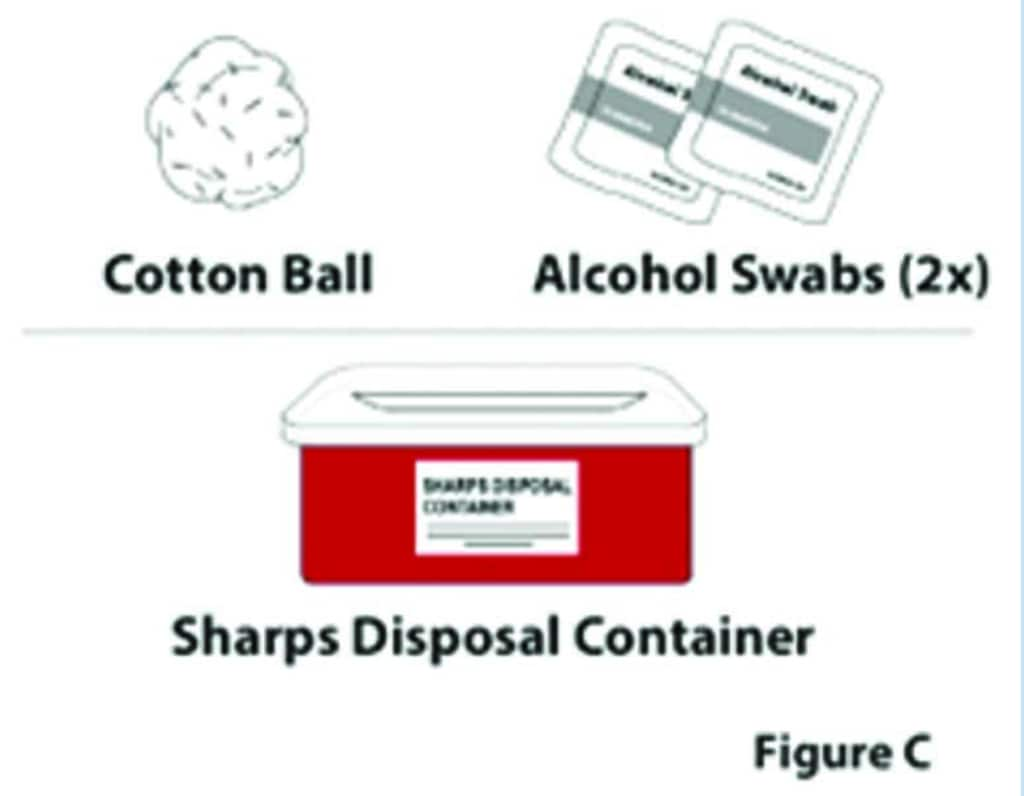
B. Remove the prefilled syringe pack from the refrigerator.
Check the expiration date on the blister pack. Do not use the Fylnetra prefilled syringe if the expiration date has passed (see Figure D).

Put the original pack with any unused prefilled syringes back in the refrigerator.
Remove the syringe tray from the pack. On a clean, well-lit surface, place the syringe tray at room temperature for 30 minutes before you give an injection.
- Do not use the prefilled syringe if the pack is damaged.
- Do not try to warm the prefilled syringe by using a heat source such as hot water or microwave.
- Do not leave the prefilled syringe in direct sunlight.
- Do not shake the prefilled syringe.
C. Remove the prefilled syringe from the blister as shown.
Open the tray by peeling away the cover. Grab the clear safety guard to remove the prefilled syringe from the tray (see Figure E).

Figure E
For safety reasons:
- Do not grab the plunger rod.
- Do not grab the gray needle cap.
D. Inspect the medicine and prefilled syringe.
Make sure the medicine in the prefilled syringe is clear and colorless (see Figure F).
- Do not use the prefilled syringe if:
- The medicine is cloudy or discolored, or contains flakes or particles
- Any part appears cracked or broken
- The prefilled syringe has been dropped
- The gray needle cap is missing or not securely attached.
- The expiration date printed on the label has passed.
In all cases, use a new prefilled syringe and call your healthcare provider.

Figure F
Step 2: Get ready
- You can use (see Figure G):
If self-injecting
If caregiver is giving you the injection
- the outer area of the upper arm
- upper outer area of the buttocks.
- thigh
- stomach-area (abdomen), except for a 2-inch area around the navel (belly button)
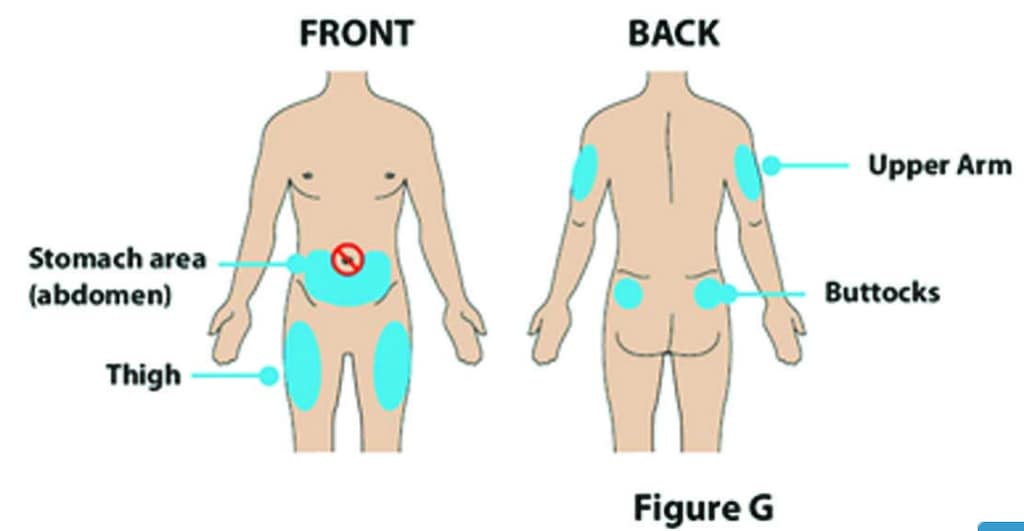
Step 3. Clean the injection site.
Clean the injection site with an alcohol wipe. Let the skin dry (see Figure H).

- Do not touch this area again before injecting.
- If you want to use the same injection site, make sure it is not the same spot on the injection site you used for a previous injection.
- Do not inject into areas where the skin is tender, bruised, red, or hard. Avoid injecting into areas with scars or stretch marks.
Subcutaneous (under the skin) injection
Step 4: Remove the needle cap.
- Hold the prefilled syringe by the syringe barrel (see Figure I). Carefully pull the needle cap off and away from the body.
- Do not twist or bend the needle cap.
- Throw away the needle cap.
- Do not hold the prefilled syringe by the plunger rod.
- Do not put the needle cap back onto the syringe. Dispose of (throw away) the needle cap in your household trash.
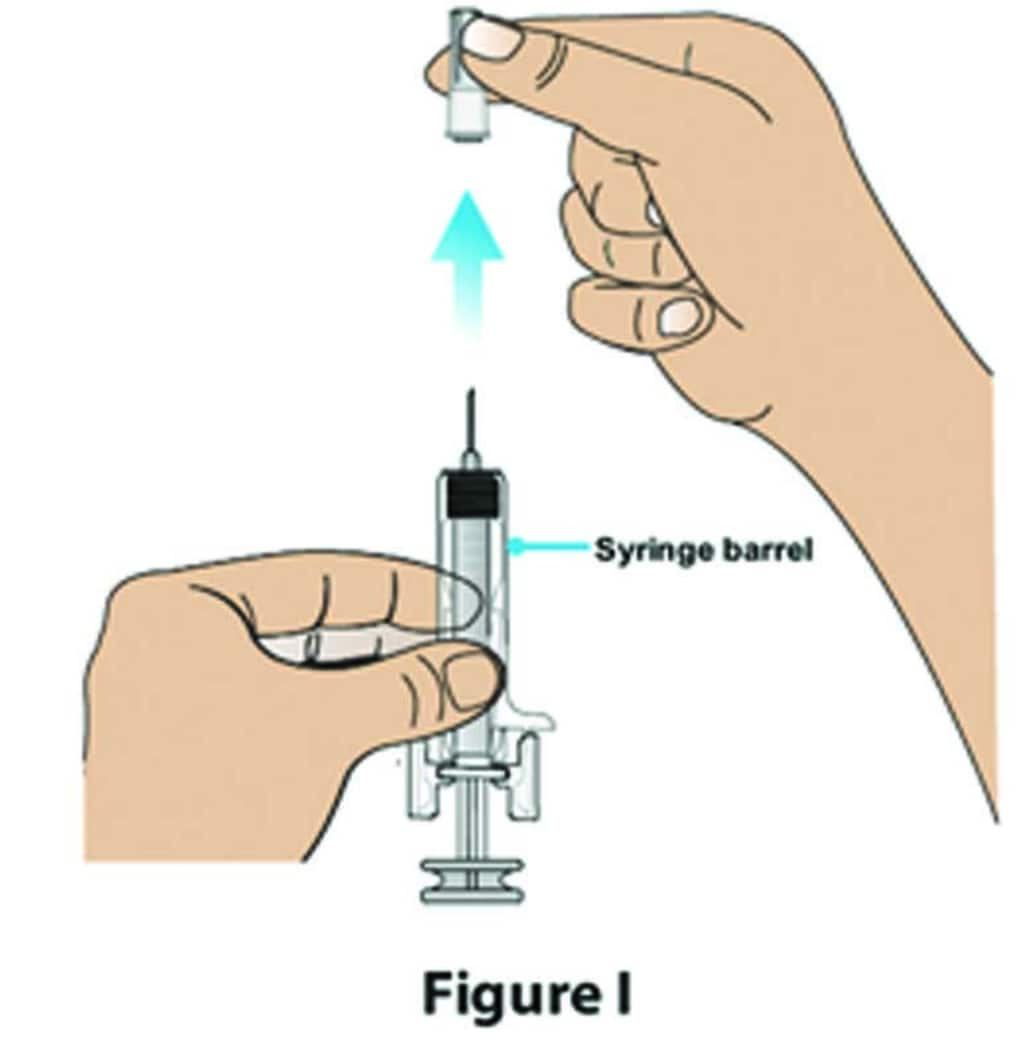
Step 5: Pinch the skin.
- Pinch the injection site to create a firm surface (see Figure J).
Important: Keep skin pinched while injecting.

Step 6: Insert the needle.
- Insert the needle into the skin at a 45 to 90 degree angle (see Figure K).

Step 7: Inject the dose.
• Using slow and constant pressure, push down the plunger rod until it reaches the bottom (see Figures L and M).
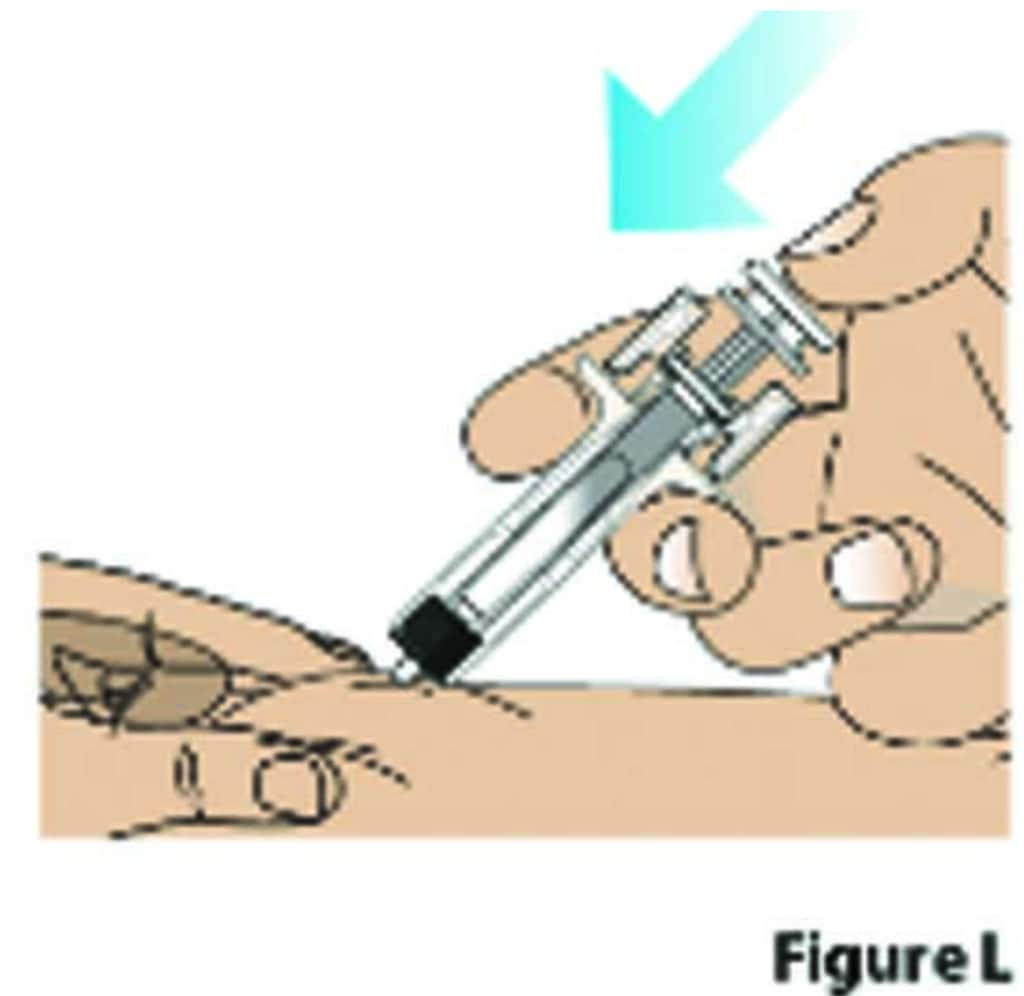

Step 8: Finish
- When the syringe is empty, keep the plunger rod fully pressed down while you carefully pull the needle straight out from the injection site and off your skin.
- Slowly release pressure, allowing the plunger head to rise up (see Figure N).

- This will allow the syringe needle guard to automatically cover the exposed needle (see Figure O). Do not recap the needle.

IMPORTANT: If the needle guard does not activate after performing this step, throw away (dispose of) the used prefilled syringe right away in a sharps disposal container (see Step 10: “Disposing of used prefilled syringes”).
Important: When you remove the syringe, if it looks like the medicine is still in the syringe barrel, this means you have not received a full dose. Call your healthcare provider right away.
After the injection
Step 9: Examine the injection site.
If there is blood, press a cotton ball or gauze on the injection site (see Figure P). Do not rub the injection site. Apply an adhesive bandage if needed.

Step 10: Disposing of used prefilled syringes
How should I dispose of (throw away) used Fylentra prefilled syringes?
- Put the used prefilled syringe in a FDA-cleared sharps disposal container right away after use (see Figure Q).
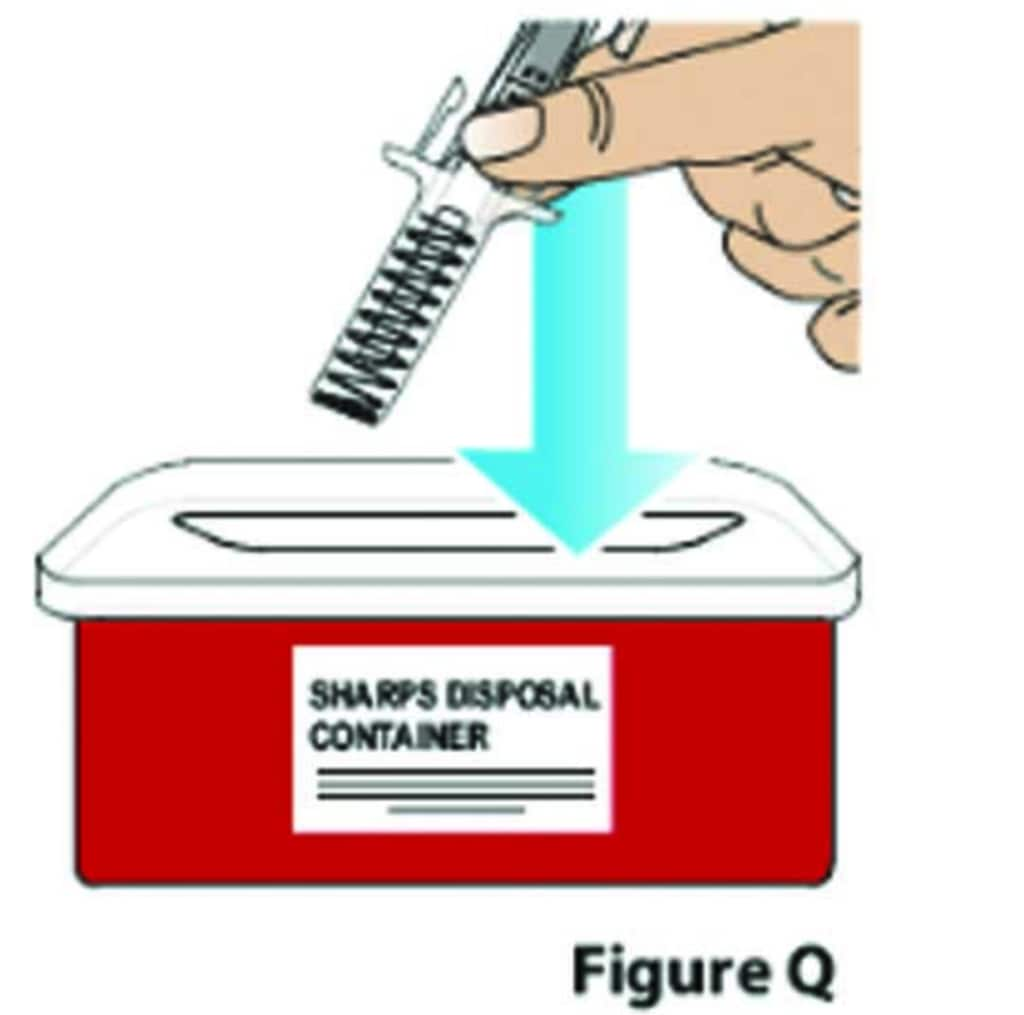
Do not throw away (dispose of) used prefilled syringes in your household trash.
- If you do not have an FDA-cleared sharps disposal container, you may use a household container that is:
- made of a heavy-duty plastic,
- can be closed with a tight-fitting, puncture-resistant lid,
- without sharps being able to come out,
- upright and stable during use leak-resistant, and
- properly labeled to warn of hazardous waste inside the container.
- When your sharps disposal container is almost full, you will need to follow your community guidelines for the right way to dispose of your sharps disposal container. There may be state or local laws about how you should throw away used needles, syringes, and prefilled syringes. For more information about safe sharps disposal, and for specific information about sharps disposal in the state that you live in, go to the FDA’s website at: HTTP://WWW.FDA.GOV/SAFESHARPSDISPOSAL.
- Do not reuse the prefilled syringe.
- Do not recycle the prefilled syringe or sharps disposal container or throw them into household trash.
Important: Always keep the sharps disposal container out of the reach of children.
Instructions for use revised 05/2022.




